三年级上册be动词
- 格式:doc
- 大小:29.00 KB
- 文档页数:2
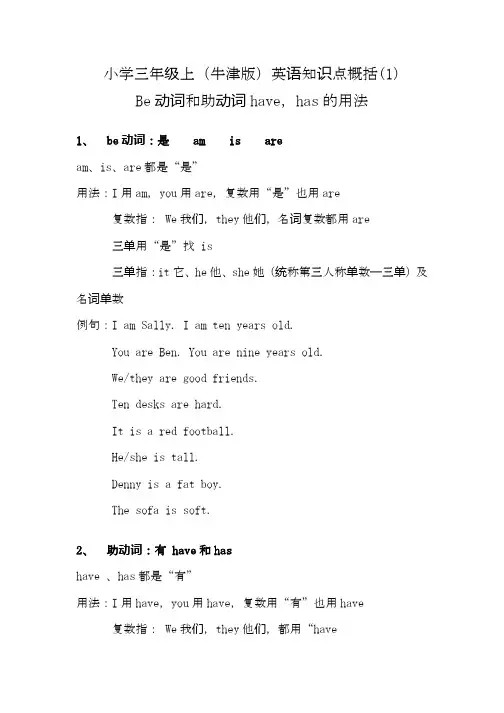
小学三年级上(牛津版)英语知识点概括(1) Be动词和助动词have,has的用法
1、be动词:是 am is are
am、is、are都是“是”
用法:I用am,you用are,复数用“是”也用are
复数指: We我们,they他们,名词复数都用are
三单用“是”找 is
三单指:it它、he他、she她(统称第三人称单数——三单)及名词单数
例句:I am Sally. I am ten years old.
You are Ben. You are nine years old.
We/they are good friends.
Ten desks are hard.
It is a red football.
He/she is tall.
Denny is a fat boy.
The sofa is soft.
2、助动词:有 have和has
have 、has都是“有”
用法:I用have,you用have,复数用“有”也用have
复数指: We我们,they他们,都用“have
三单用“有”都找has
三单指:it它、he他、she她(统称第三人称单数——三单)例句:I have two pens。
You have a pencil case.
They/we have many books.
It has long tail.
He/she has a bag.
Ben has a toy car.。
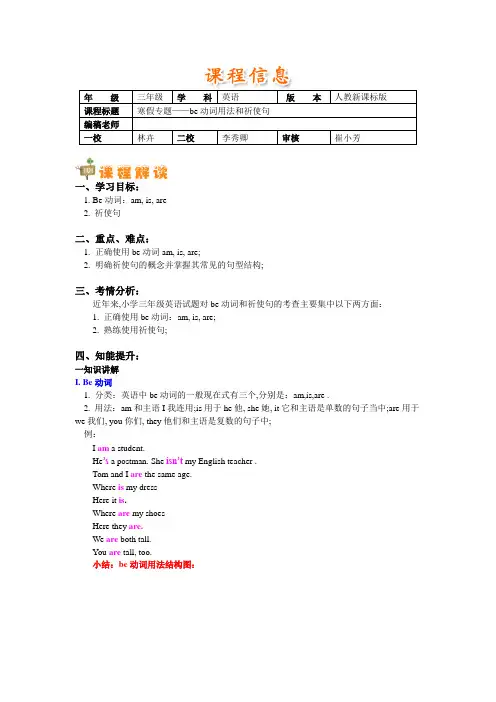
年级三年级学科英语版本人教新课标版课程标题寒假专题——be动词用法和祈使句编稿老师一校林卉二校李秀卿审核崔小芳一、学习目标:1. Be动词:am, is, are2. 祈使句二、重点、难点:1. 正确使用be动词am, is, are;2. 明确祈使句的概念并掌握其常见的句型结构;三、考情分析:近年来,小学三年级英语试题对be动词和祈使句的考查主要集中以下两方面:1. 正确使用be动词:am, is, are;2. 熟练使用祈使句;四、知能提升:一知识讲解I. Be动词1. 分类:英语中be动词的一般现在式有三个,分别是:am,is,are .2. 用法:am和主语I我连用;is用于he他, she她, it它和主语是单数的句子当中;are用于we我们, you你们, they他们和主语是复数的句子中;例:I am a student.He’s a postman. She isn’t my English teacher .Tom and I are the same age.Where is my dressHere it is.Where are my shoesHere they are.We are both tall.You are tall, too.小结:be动词用法结构图:is Tom It She He not m I')(am I ⎪⎭⎪⎬⎫↓否 t isn')(否 are boys The I and Tom You They We ⎪⎪⎪⎭⎪⎪⎪⎬⎫否aren’t be 动词用法歌诀:Be 动词,兄弟仨,am, is, 还有are ;我I 用am ,你you 用are ,is 用于他he, 她she, 它it ;单数名词用is, 复数名词都用are ;考题链接1. Hello Here _____an orange for youA. am B . is C. are答案:B思路分析:主语an orange 是单数形式;2. My books _____ very useful .A. am B . is C. are答案:C思路分析:主语My books 是复数形式;3. I have two pens. They ____ new. One ____ green and the other _____ blue .A. am, is ,amB. is, are, isC. are, is, is答案:C思路分析:主语they 是复数形式;One 是单数形式,the other 意为“另一个”,也是单数形式;II. 祈使句<一>定义:祈使句表示请求、命令、建议等;谓语动词一律用原形;句子中通常不用主语,句末用惊叹号或句号,用降调来读;<二>分类:肯定的祈使句和否定的祈使句.1. 肯定的祈使句a. 句型:动词原形~.省略主语Stand up.起立;Be quiet,please.请安静;比较 陈述句:You sit down.你坐下来;祈使句:Sit down.坐下;省略主语you注意:有时,为了加强语气,可在动词之前加do;Do sit down.务必请坐;Do study hard.一定要努力学习;b. 用客气的语气表示祈使句时,可在句首或句尾加上please,但如果在句尾加please,那在please 之前一定要加一个逗号“,”;Come this way,please.请这边走;注意:祈使句中如果有呼唤语,一定要用“,”隔开,呼唤语可出现在句首或句尾;Li Ming,come here.李明,过来;Come here,Li Ming.过来,李明;c. 含有第一、第三人称的祈使句Let's say good-bye here.我们在此道别吧;Don't let him do that again.别让他再那么做了;句型:Let+第一人称me,us~.Let+第三人称代词宾格:him,her,it,them或名词~.Let's go at once.咱们马上动身吧;Let me try again.让我再试试;Let Tom go there himself.让汤姆自己去那儿;注意:Let's包括听话者,Let us不包括听话者;用于反意疑问句时最明显;Let's go,shall we咱们去吧,怎么样Let us help you,will you 让我们帮帮你,好吗2. 否定的祈使句句型a:Don't +原形~Don't swim in the river.别在河里游泳;Don't be late.别迟到;Please don't be noisy.请不要大声喧哗;注意:表示禁止时,尤其是标语等也可用“No+/”的形式来表示;No smoking禁止吸烟No parking禁止停车No litter不准乱扔杂物句型b:Let'sus,me+not +动词原形~.Don't let +第三人称代词的宾格或名词+动词原形.Let's not say anything about it.对于这件事,咱们什么也不要说;Don't let them play with fire.别让他们玩火;易错点1. be 动词的缩写形式:I am =I'm he is =he's it is = it's she is = she's you are=you're we are = we'rethey are = they're is not =isn't are not = aren'tam not 没有缩写形式.I'm不能用在句末;2. 祈使句的回答:回答祈使句时,应该说“OK./ All right./ Great./Good idea.”好的,好吧,好极了决不能用“That's OK./ That's all right .”没关系如:—Let's fly it .—Great—Show me your ruler .—All right .考题链接1. ________ the duck yellow .A. colourB. ColourC. Colours答案:B思路分析:"colour"作动词时意为“给……涂色”;作名词时意为“颜色”;祈使句需以动词原形开头且首字母要大写;2. ___________draw a monkey .A. LetB. LetsC. Let's答案:C思路分析:“Let's”是Let us 的缩写形式;意为“让我们……”“Let us +动词原形”构成祈使句;3. —Are you a student—Yes, ______.A. I areB. I amC. I'm答案:B思路分析:I 必须与am 连用,但I'm不能用在句末;4. Everyone _____here today .A. amB. isC. are答案:B思路分析:主语是复合不定代词时,谓语动词用单数;5. —_____this your chair—Yes , it is.A. AmB. AreC. Is答案:C思路分析:"this "意为“这个”,是单数;主语是单数时,谓语动词须用单数;二即学即练Ⅰ. 用“am , is , are ”填空:1. This____ my mouth .2. How ____you3. What______ your name4. Mr Wang _____ a good teacher .5. My shoes ______very beautiful .6. _____that your brother7. Everything ____ OK .8. I _____ tall and thin.II. 连词成句;注意大小写及标点符号1. are, how , you____________________ ____2. show , me , your, pencil-box . ___________________3. at, my , train , look. ___________ ___ _____4. Let, me, a , look, have . _____________________5. colour, pink , it , and, blue . ______________________下册Unit 1 Let's go to school . L1-L2一、预习新知下节课的主要内容,包括单词:classroom school storybook water bottle;句型:Let’s go to school .Nice to see you again .Look I have a new...Can I see itSure .Here you are .二、预习点拨思考问题一:新学期开始了,见到同学们你知道该说些什么吗思考问题二:同学们知道怎样用英语说“学校,教室,故事书和水瓶”吗答题时间:30分钟Ⅰ. 用“am , is , are ”填空:Hello My friends. How___ youNow, I will talk about my family and me. There ____four people in my family. They ____ my father, my mother, my little brother and I. My father ___ a doctor. My mother ____ a teacher. My brother ___only 3 years old. He ___lovely.可爱的.I ____ 10 years old now. I____ in Class1, Grade love my family .II. 单项选择:1. ____ it pink and blue .A. LookB. ColourC. Is2. ______ draw an egg.A. LetB. LetsC. Let’s3. ____ some rice, please .A. haveB. HaveC. Drinka pear for you .A. areB. amC. is5. Here you _____ .A. amB. isC. are6. We ___ all here today.A. amB. isC. are7. _____make any noise .A. Don'tB. NotC. Can8. I like my house. It____ big .A. amB. isC. are9. —What _____this, Li Yan —____elephant.A. is, AB. are, AC. is, An10. —Is that ____ eraser —Yes, it____ .A. a, isB. an, isC. an, isn'tⅠ. 用“am , is , are ”填空:Hello My friends. How __are_ youNow, I will talk about my family and me. There are four people in my family. They are my father, my mother, my little brother and I. My father is a doctor. My mother_ is a teacher. My brother is only 3 years old. He is lovely.可爱的.I am 10 years old now. I am in Class1, Grade love my family .II. 单项选择:B 1. ____ it pink and blue .A. LookB. ColourC. IsC 2. ______ draw an egg.A. LetB. LetsC. Let’sB 3. ____ some rice, please .A. haveB. HaveC. DrinkC 4. Here_____ a pear for you .A. areB. amC. isC 5. Here you _____ .A. amB. isC. areC 6. We ___ all here today.A. amB. isC. areA7. _____make any noise .A. Don'tB. NotC. CanB8. I like my house. It____ big . .A. amB. isC. areC9. —What _____this, Li Yan—____elephant.A. is, AB. are, AC. is, AnB10. —Is that ____ eraser—Yes, it____ .A. a, isB. an, isC. an, isn't。
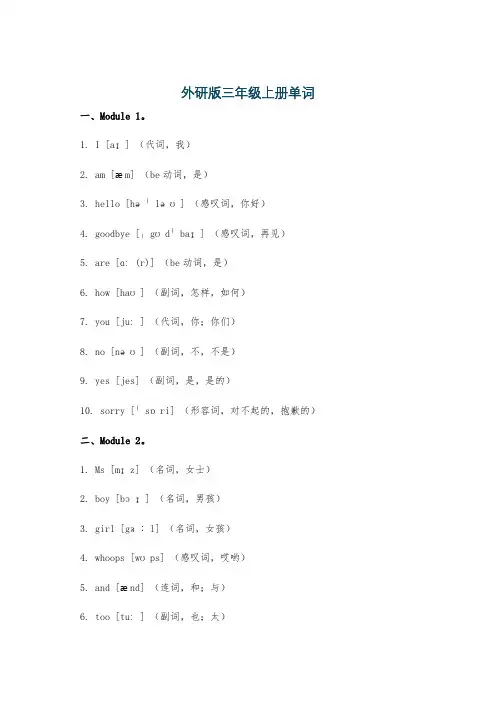
外研版三年级上册单词一、Module 1。
1. I [aɪ] (代词,我)2. am [æm] (be动词,是)3. hello [həˈləʊ] (感叹词,你好)4. goodbye [ˌgʊdˈbaɪ] (感叹词,再见)5. are [ɑː(r)] (be动词,是)6. how [haʊ] (副词,怎样,如何)7. you [juː] (代词,你;你们)8. no [nəʊ] (副词,不,不是)9. yes [jes] (副词,是,是的)10. sorry [ˈsɒri] (形容词,对不起的,抱歉的)二、Module 2。
1. Ms [mɪz] (名词,女士)2. boy [bɔɪ] (名词,男孩)3. girl [gɜːl] (名词,女孩)4. whoops [wʊps] (感叹词,哎哟)5. and [ænd] (连词,和;与)6. too [tuː] (副词,也;太)三、Module 3。
1. what [wɒt] (代词,什么)2. is [ɪz] (be动词,是)3. your [jɔː(r)] (形容词性物主代词,你的;你们的)4. name [neɪm] (名词,名字)5. please [pliːz] (感叹词,请)四、Module 4。
1. it [ɪt] (代词,它)2. red [red] (形容词,红色的;名词,红色)3. look [lʊk] (动词,看)4. blue [bluː] (形容词,蓝色的;名词,蓝色)5. a [ə; eɪ] (冠词,一(个,件……))6. green [ɡriːn] (形容词,绿色的;名词,绿色)7. yellow [ˈjeləʊ] (形容词,黄色的;名词,黄色)8. black [blæk] (形容词,黑色的;名词,黑色)9. dog [dɒɡ] (名词,狗)10. cat [kæt] (名词,猫)11. cap [kæp] (名词,帽子)五、Module 5。
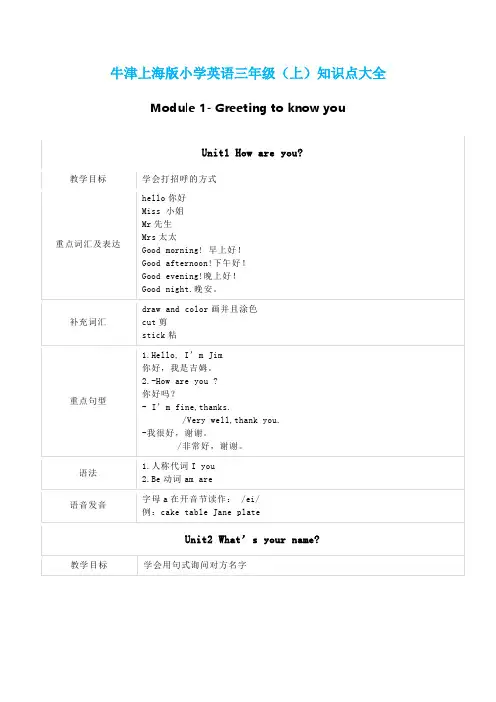
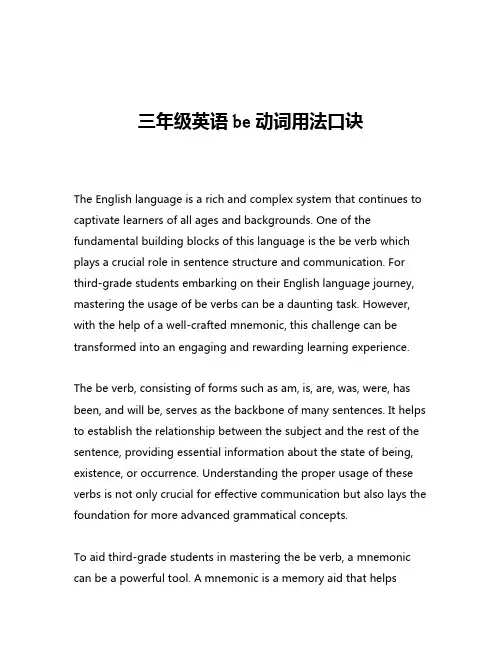
三年级英语be动词用法口诀The English language is a rich and complex system that continues to captivate learners of all ages and backgrounds. One of the fundamental building blocks of this language is the be verb which plays a crucial role in sentence structure and communication. For third-grade students embarking on their English language journey, mastering the usage of be verbs can be a daunting task. However, with the help of a well-crafted mnemonic, this challenge can be transformed into an engaging and rewarding learning experience.The be verb, consisting of forms such as am, is, are, was, were, has been, and will be, serves as the backbone of many sentences. It helps to establish the relationship between the subject and the rest of the sentence, providing essential information about the state of being, existence, or occurrence. Understanding the proper usage of these verbs is not only crucial for effective communication but also lays the foundation for more advanced grammatical concepts.To aid third-grade students in mastering the be verb, a mnemonic can be a powerful tool. A mnemonic is a memory aid that helpsindividuals associate a specific piece of information with an easy-to-remember phrase or acronym. In the case of be verb usage, a well-designed mnemonic can simplify the complex rules and patterns, making them more accessible and memorable for young learners.One such mnemonic that can be particularly useful for third-grade students is the phrase "I AM the Be Verb King." This mnemonic not only helps students remember the various forms of the be verb but also encourages them to actively engage with the concept and take ownership of their learning.Let's break down the mnemonic and explore how it can be applied to the be verb usage:I - This part of the mnemonic represents the personal pronoun "I," which is the first-person singular subject. It serves as a reminder that the be verb must agree with the subject of the sentence.AM - This form of the be verb is the first-person singular present tense. It is used when the subject is "I" and the action or state of being is happening in the present.the - This word serves as a transition, leading the learner to the next part of the mnemonic.Be - This is the root form of the be verb, which encompasses all its various conjugations and forms.Verb - This term explicitly identifies the be verb as a verb, reinforcing the understanding that it is an action word that plays a crucial role in sentence construction.King - This final part of the mnemonic personifies the be verb as a "king," emphasizing its importance and dominance in the English language. It also suggests that the learner is the "king" of be verb usage, instilling a sense of confidence and mastery.By breaking down the mnemonic and understanding the significance of each component, third-grade students can effectively internalize the various forms and usage of the be verb. The "I AM the Be Verb King" mnemonic not only helps students remember the different conjugations but also encourages them to actively engage with the concept, fostering a deeper understanding and ownership of the material.Furthermore, the mnemonic can be further reinforced through engaging activities and exercises. For example, students can create their own sentences using the different be verb forms, practice identifying the correct be verb in given sentences, or even compose short stories or dialogues that showcase their mastery of the be verbusage.As students progress through their third-grade English language curriculum, the "I AM the Be Verb King" mnemonic can serve as a valuable tool that not only aids in memorization but also promotes critical thinking and problem-solving skills. By understanding the underlying logic and patterns of the be verb, students can develop a stronger foundation in grammar, which will serve them well as they continue their language learning journey.In conclusion, the "I AM the Be Verb King" mnemonic is a powerful and effective tool for third-grade students learning English. By breaking down the complex rules and patterns of be verb usage into a simple, memorable phrase, this mnemonic helps students internalize the concepts, build confidence, and develop a deeper appreciation for the nuances of the English language. As educators and parents work together to support the academic growth of third-grade students, the incorporation of this mnemonic can be a valuable addition to the learning toolkit, ensuring that the be verb becomes a trusted ally in their language acquisition journey.。
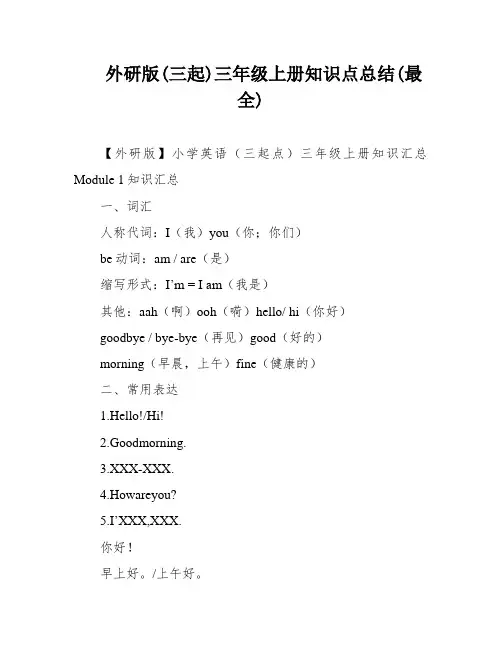
外研版(三起)三年级上册知识点总结(最全)【外研版】小学英语(三起点)三年级上册知识汇总Module 1知识汇总一、词汇人称代词:I(我)you(你;你们)be动词:am / are(是)缩写形式:I’m = I am(我是)其他:aah(啊)ooh(嗬)hello/ hi(你好)goodbye / bye-bye(再见)good(好的)morning(早晨,上午)fine(健康的)二、常用表达1.Hello!/Hi!2.Goodmorning.3.XXX-XXX.4.Howareyou?5.I’XXX,XXX.你好!早上好。
/上午好。
再会。
你好么?/你好。
我很好,感谢你。
三、重点句型自我介绍的句型:I’m。
/ I am。
eg: I am Liu Mei.I’m XXX.Module 2知识汇总一、词汇be动词:is(是)缩写方式:what’s = what is(是甚么)其他:Ms(密斯)boy(男孩)girl(女孩)whoops(哎呦)and(那么;和)too(也)ha ha(哈哈)what(什么)your(你的;你们的)name(名字)please(请)XXX(下午)Mr(先生)二、常用表达1.I’XXX,too.2.XXX.3.Yourname,please?我也很好。
下战书好。
请问你叫什么名字?3、重点句型讯问对方名字:-What’s your name?-My name is。
eg:-What’s your name?-My name is XXX.Module 3知识汇总一、词汇1.point指2.to向……3.the这(那)个,这(那)些4.door 门5.sit坐6.down向下7.stand站8.up向上9.window窗户10.blackboard黑板11.bird鸟12.XXX(鸟)啾啾的叫声13.desk桌子14.chair椅子2、经常使用表达1.Sitdown,please.2.XXX.3.What’syourname?三、重点句型1.Point to +某人/某物.指向某人或某物。
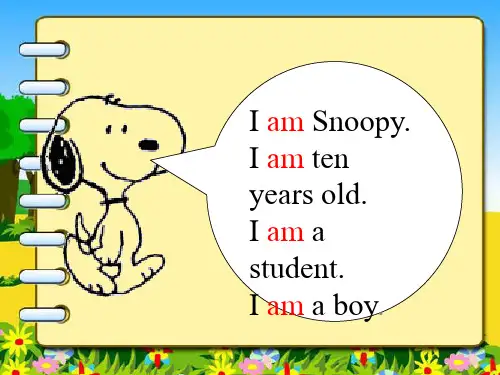

三年级孩子不理解be动词和助动词be动词,即am,is,αre,wαs,were,意思为"是",是连接主语和表语的动词,有时不译。
如,I am a teacher.我是一个老师!She is old.她年纪大了!We are happy.我们很高兴!He was at home.他在家。
They were right.他们是对的!be动词有时跟其他动词结合,形成各种时态和语态,叫助动词!这时be动词不单独翻译,没有单独的词义!如下列句子:I am going to see a movie this evening.我打算今晚看电影。
We are thinking of it.我们正在考虑!He was sleeping in the bed.他正躺在床上!They have been there twice.他们已去那两次了!The watch is made in Sweden.这表瑞士产的。
除be可作助动词,do,does,did,will,sha1l,have,hαs,hαd也作助动词,形成各种时态。
do和does是一般现在时的助动词。
形成否定句和疑问句,肯定句不需要,这时,do和does无词义,不译!Do they live inBeijing?Does Bob love his family?We don't take art classes.What do they have for dinner?did是一般过去时的助动词,形成否定句和疑问句,肯定句不需要,这时,did无词义,不译!Dⅰd you stay at home?丫es,I did.She didn't meet us.will,shall是一般将来时态的助动词,有词义,表"将要","会",如,Ⅰ will ride to work.have.has 是现在完成时的助动词,与其后的过去分词结合成谓语,表示"已经...."不单独翻译!I have seen this film.He has gone home.had是过去完成时的助动词,与其后的过去分词结合成谓语,表示"已经...."也不单独翻译!I had left there before he arrived.。
![[译林版]小学英语三至六年级所学动词及其形式](https://uimg.taocdn.com/f675df14f111f18583d05af5.webp)
译林小学英语三至六年级所有动词及其形式Be动词:原形be;is, am的过去式是was;are的过去式是were.助动词:原形do;三单式does;过去式did情态动词有:can(能够;可以), could(能够), may(可以;也许), must(必须), shall (必须;应该;可以;将要;), should(应该), will(将要), would(愿意;将要)…句型转换的方法Be动词:原形be;现在式is, am, are;;过去式was, were情态动词有:can, could, may, must, shall, should, will, would…助动词:原形do;三单式does;过去式did一、肯定句否定句1. 加not①有be动词,直接在be动词后面加not,可缩写。
②有情态动词,直接在情态动词后加not,可缩写。
③无be无情,助动词don’t/doesn’t/d idn’t来帮忙,句中动词用原形。
2. 改:①some改成any, ②and改成or,③too改成either例:①I am at home. I am not at home.②I can dance well. I can’t dance well..二、肯定句一般疑问句1. 提①有be提be(有be动词,将be动词提到句首)②有情提情(有情态动词,将情态动词提到句首)③无be无情,助动词来帮忙(没有be动词,也没有情态动词,就在句首加上助动词do/does/did,句中动词用原形)2.改①第一、第二人称互换(I, me, we, us ---you, my, our---your②some改成any, and改成or③句号改成问号例:①I am at home.Are you at home? Yes, I am. / No, I’m not.②I can dance well.Can you dance well? Yes, I can. / No, I can’t.三、肯定句特殊疑问句(对划线部分提问)1. 确定疑问词(将划线部分换成对应的疑问词)人——who/whom 事,物——what地点——where 时间——when / what time原因——why 数量——how many频率——how often 价钱——how much颜色——what colour 年龄——how old长度——how long 距离——how far 还有how, which, whose等。
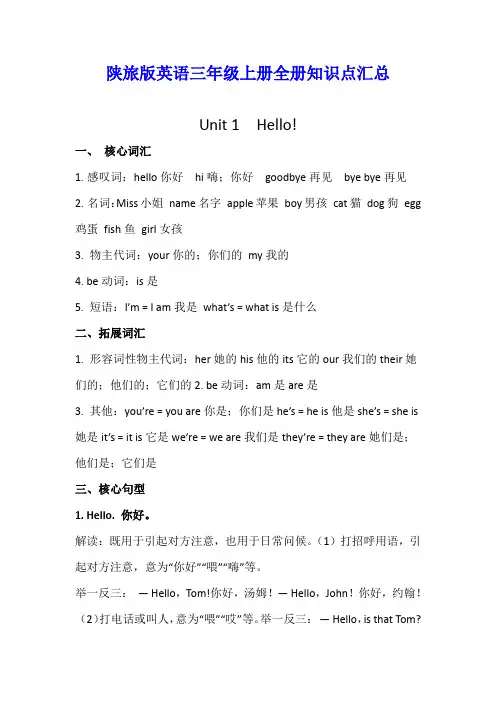
陕旅版英语三年级上册全册知识点汇总Unit 1 Hello!一、核心词汇1.感叹词:hello你好hi嗨;你好goodbye再见bye bye再见2.名词:Miss小姐name名字apple苹果boy男孩cat猫dog狗egg 鸡蛋fish鱼girl女孩3. 物主代词:your你的;你们的my我的4. be动词:is是5. 短语:I’m = I am我是what’s = what is是什么二、拓展词汇1. 形容词性物主代词:her她的his他的its它的our我们的their她们的;他们的;它们的2. be动词:am是are是3. 其他:you’re = you are你是;你们是he’s = he is他是she’s = she is 她是it’s = it is它是we’re = we are我们是they’re = they are她们是;他们是;它们是三、核心句型1. Hello. 你好。
解读:既用于引起对方注意,也用于日常问候。
(1)打招呼用语,引起对方注意,意为“你好”“喂”“嗨”等。
举一反三:— Hello,Tom!你好,汤姆!— Hello,John!你好,约翰!(2)打电话或叫人,意为“喂”“哎”等。
举一反三:— Hello,is that Tom?喂,是汤姆吗?— Yes. This is Tom. 是的。
我是汤姆。
2.Hi. 嗨。
解读:常用于引起对方注意的打招呼用语,比“Hello!”更随意。
举一反三:— Hi,Eric!嗨,艾瑞克!— Hi,Lucy!嗨,露西!3.Goodbye. 再见。
解读:这是表示“再见” 的常用句型。
“Goodbye!” 是大家常用的且较为正式的告别语,多对陌生人、年长的人说。
日常生活中,我们还可以说“Bye bye.”,但“Bye bye.”较为口语化。
举一反三:— Goodbye,Danny. 再见,丹尼。
— Goodbye,Mary. 再见,玛丽。
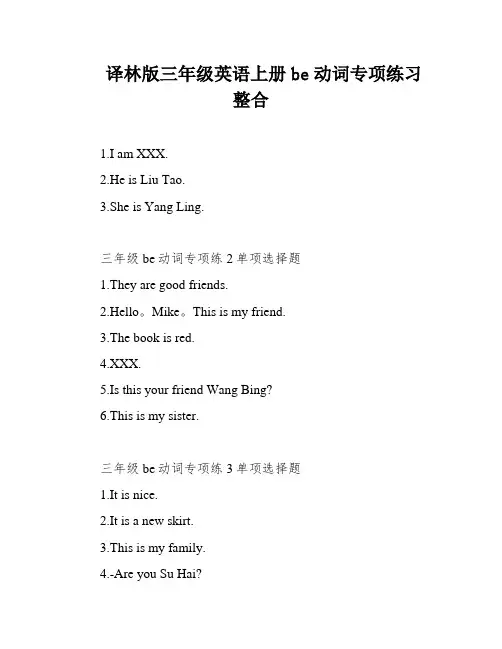
译林版三年级英语上册be动词专项练习整合1.I am XXX.2.He is Liu Tao.3.She is Yang Ling.三年级be动词专项练2单项选择题1.They are good friends.2.Hello。
Mike。
This is my friend.3.The book is red.4.XXX.5.Is this your friend Wang Bing?6.This is my sister.三年级be动词专项练3单项选择题1.It is nice.2.It is a new skirt.3.This is my family.4.-Are you Su Hai?Yes。
I am.5.Are you Wang Bing?6.-What colour is your new cap?It is red.三年级be动词专项练4选择括号中适当的单词填空1.I am XXX.2.He is Liu Tao.3.She is Yang Ling.4.This is my XXX.5.Are you Wang Bing?6.Is this your father?三年级be动词专项练5选择括号内适当的单词填空1.What colour is your skirt。
- It's red.2.Hello。
Mike。
This is my friend。
Yang Ling.3.XXX.4.My cap is blue.5.Is this your friend Wang Bing?6.This XXX.三年级be动词专项练6选择括号内适当的单词填空1.Look at my jacket。
The jacket is yellow.2.Are you Wang Bing?3.This T-shirt is blue.4.This is my XXX。
XXX.5.I am a boy.6.She is a nice girl.三年级be动词专项练7用be(am。
外研版(三起)三年级英语上册全册知识点清单Module 1一、核心词汇1. 人称代词: I我you你;你们2. 感叹词: aah啊hello(hi)你好ooh嗬goodbye(bye-bye)再见3. be动词: am是are是4. 形容词: good好的fine健康的5. 表示时间的名词: morning早晨,上午6. 动词: thank谢谢二、拓展词汇1. 其他常见人称代词: he他she她it它we我们they他(她、它)们2. be动词: is是3. 其他表示时间的名词: noon中午,正午afternoon下午night晚上,夜晚三、核心句型1. Hello, I m Sam. 你好,我是萨姆。
解读:这是进行自我介绍时的一般用语,也可用来回答“What s your name?”这个询问对方姓名的问句。
句中的I m 是I am的缩写形式,其中am为be动词且只用在I后。
举一反三: I m Li Ming.=I am Li Ming. 我是李明。
2. — Goodbye, Lingling. 再见,玲玲。
— Goodbye, Daming. 再见,大明。
— Bye-bye, Amy. 再见,埃米。
— Bye-bye, Sam. 再见,萨姆。
解读:这是表示“再见”的常用句型。
“Goodbye!”是大家常用的且较为正式的告别语,多用于陌生人或年长的人。
“Bye-bye.”则较为口语化。
举一反三: — Goodbye, it s too late. 再见,太晚了。
— Bye-bye. 再见。
3. Good morning, Daming!早上好,大明!解读:这是在一天的早上或上午向他人问好的句型。
举一反三: — Good morning, everyone. 大家早上好。
— Good morning, Mrs Green. 早上好,格林夫人。
4. — How are you, Sam? 你好么,萨姆?— I m fine, thank you. 我很好,谢谢。
三年级英语上册U1 Hello! 你好!what [wɒt] 什么is [ɪz] 是(be 动词)your [jɔ:]你的;你们的name [neɪm] 名字;姓名hi [haɪ] 喂,你好hello [hə'ləu] 喂,你好my [maɪ] 我的I [aɪ] 我am [æm]是(be动词)and [ænd]和,与good morning 早上好children ['tʃɪldrən] 孩子,儿童goodbye 再见bye 再见句型:S1: What’s your name? 你叫什么名字?My name’s Mocky. 我的名字叫Mocky. S2: I’m Ken. 我叫Ken.日常用语:S1:Hello !/ Hi! 你好!S2: Good morning./ Morning. 早上好.S3: Goodbye./ Bye. 再见. S4: Wake up. 醒醒.注:what’s= what is I’m= I am my name’s= my name is 语音:Aa[æ]Bb[b]Cc [k]Dd[d]U2 Friends 朋友this [ðɪs] 这,这个look [lʊk] 看a [ə] 一(个,只)deer [dɪə]鹿it [ɪt] 它tiger ['t aɪɡə]老虎that [ðæt] 那,那个no [nəu] 不,不行not [nɒt] 不,没,不是cat [kæt]猫dog [dɒg]狗cow [k aʊ]奶牛panda ['pændə]熊猫horse [hɔ:s]马句型:S1: What’s this? 这是什么?It’s a dog. 它是一只狗。
S2: What animal is it? 它是什么动物?It’s a cat. 它是一只猫。
S3: It’s not Lulu. 它不是Lulu.It’s a tiger. 它是一只老虎. 注:it’s = it is日常用语:S1:This is Danny Deer. 这是小鹿丹尼.Hello, Danny Deer. 你好,小鹿丹尼.S2: What a lovely cat! 多么可爱的猫啊!S3: Super. 棒极了.S4: Help! 救命!S5: I know. 我知道.S6: Be careful. 小心.S7: Thank you. 谢谢你.语音:Ee[e] Ff[f] Gg[g] Hh[h] Ii[I]U3Playing together 一起玩pass [pɑ:s]传the [ðə]这,那ball [bɔ:l]球play [pleɪ]玩,玩耍football [ˈfʊtbɔ:l]足球OK 好,行,可以catch [kætʃ]接住,抓住kick [kɪk]踢throw [θrəʊ]扔who [hu:] 谁he [hi:]他cousin ['kʌzn](堂)表兄弟姐妹she [ʃi:]她friend [frend] 朋友句型:S1:Who’s this? 这是谁?This is Cathy. 这是凯西.She’s my friend. 她是我的朋友。
be 动词填空练习(圈出关键词)I 用,you 用户,he/she/it 用.练习:1.I Alice. I ten years old.2.Which grade you? I in Grade Three.3.Sandy my good friend. He tall and fat.4.Look at the picture. It beautiful.5.Who she? She my sister.is, are,一个人名还用.练习:1.The panda big and fat.2.Jim a schoolboy. His mother and father teachers.3.Which grade Jenny in? She in Grade 1.4.Mr. Wang and Mr. Sun friends.5.The policemen tall. They tall man./ 用is, / 就用are.练习:1.This my dog. I like it.2.These chocolates sweet.3.those your teacher? Yes, they .4.What these? They eggs.5.What these? They peaches.圈出关键词并选词填空(用am, is, are 填空)1.You Miss Wang. You my English teacher.2.Where you? We in the classroom.3.it me? No. It your classroom.4.you a nurse? Yes, I .5.Where my pencil-box? It under the book.6.The young doctor handsome.7.this a picture? Yes, it a nice picture.8.Mary and I pupils. We in the classroom.9.Tom from London. Miss Green from Paris.10.What that woman? A nurse.11.What color your book? It red.12.How you? I fine.13.Your father a policeman. He cool.14.We in the computer room.15.the duck on the river?No, it a goose.16.Look! The drives over there.17.The erasers dirty. I right?18.How many the sweets? They eight.。
三年级上册be动词姓名:
be动词(是动词)有三个(is, am , are)
I am What is Who is It is
我是是什么是谁它是
He is She is You are This is That is
他是她是你是这是那是
name is My mother is My father is My sister is
名字是我的妈妈是我的爸爸是我的姐妹是
My brother is your mother is your father is your sister is 我的兄弟是你的妈妈是你的爸爸是你的姐妹是your brother is his mother is his father is his sister is
你的兄弟是他的妈妈是他的爸爸是他的姐妹是
his brother is her mother is her father is her sister is 他的兄弟是她的妈妈是她的爸爸是她的姐妹是her brother is Tony is Jenny is Gogo is Lisa is
她的兄弟是托尼是珍妮是高高是莉莎是Ben is Boomer is Bonnie is Is this Is that
苯是
Are you Is your mother Is your father Is your sister
Is your brother Is his mother Is his father Is his sister
Is his brother Is her mother Is her father Is her sister
Is her brother Is Tony Is Jenny Is Gogo Is Lisa
Is Ben Is Boomer Is Bonnie Is he Is she
用is, am, are的适当形式填空。
1. I____ a girl. You _____ a boy.
2. This ____ a panda. That(那) _____ an elephant.
3. It_____ an apple .
4. What____ this? It_____ a lion.
5. He_____ my father.
6. Who’s she ? She _____ my grandmother.
7. Who_____ she? She’s my mother.
8. Who’s he? He_____ my friend.
9. ____ this a tiger? Yes, it _____.
10. _____ that a hippo? No, it isn’t
11. What ____ it? It’s a monkey .
12. Who ____ that boy? He____ my friend.
13. What’s his name? His name_____ Ben.
15. How ______ you? I____ fine, thanks.
16. How ____ your mother? She’s fine, thank you.
19. ____ it a book ? Yes, it _____.
21. He ____ my friend. His name _____ Ben.
23. _____ this a dog? No, it_______ .
24. I_____ Tony. You _____Jenny.。